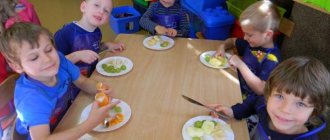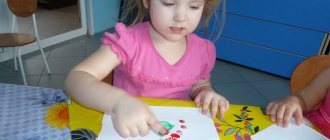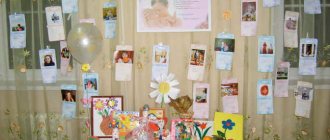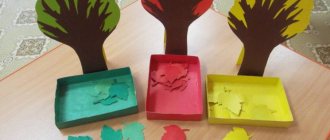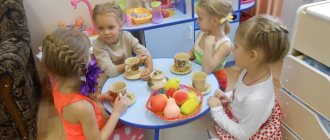Card index of games for labor education of preschoolers
Labor education in kindergarten
“Who works where?” Goal: to clarify children’s ideas about where people of different professions work and what their workplace is called. Kindergartener; school teacher; doctor - in a hospital, clinic, kindergarten, school; cook - in the kitchen, dining room, restaurant, cafe... etc. “Who knows and can do this?” Goal: to expand children’s ideas about what knowledge and skills people of different professions should have. Knows children's poems, tells fairy tales, plays and walks with children... a teacher. Plays the piano, knows children's songs, teaches singing, dancing, plays musical games with children... music director. Knows the human body, can provide first aid, knows how to recognize and treat diseases... a doctor, etc. “Who does this?” Goal: to train children in the ability to determine the name of a profession by the names of actions. Cuts, styles, washes, combs, dries... hairdresser. Soaks, soaps, washes, shakes, dries, irons... the laundress. Packs, weighs, cuts, wraps, counts... the seller. Cleans, washes, fries, cooks, cooks, salts, tastes, feeds... cook, etc. "Who's doing what?" Goal: to expand and clarify children’s ideas about the work (labor operations) of people of different professions. The janitor sweeps, cleans, waters, rakes... The music director sings, plays, dances, teaches... The junior teacher (nanny) washes, cleans, wipes, covers, dresses, reads... etc. “Correct the mistake” Goal: to teach children to find and correct mistakes in the actions of people of various professions. The cook treats, and the doctor cooks. The janitor sells, and the seller sweeps. The teacher cuts the hair and the hairdresser checks the notebooks. The musical director does the laundry, and the laundress sings songs with the children... etc. “For a person in what profession is this necessary?” Goal: to expand children’s understanding of the items necessary for a person in a certain profession. Scales, counter, goods, cash register... - to the seller. Broom, shovel, hose, sand, crowbar, snow blower... - to the janitor. Washing machine, bath, soap, iron... - to the laundress. Comb, scissors, hair dryer, shampoo, hairspray, hair clipper... - to the hairdresser, etc. “Who needs what for work?” Goal: to expand and clarify children’s ideas about the objects of the surrounding world (materials, tools, equipment, etc.) necessary for work by people of different professions. For the teacher - a pointer, textbook, chalk, blackboard... For the cook - a pot, frying pan, knife, vegetable cutter, electric oven... For the driver - a car, spare tire, gasoline, tools... For the art teacher - brushes, easel, clay, paints... etc. “Clap your hands if it is necessary for ... (name of profession)” Purpose: to exercise the ability to correlate words and phrases with a specific person’s profession. Children are invited to clap their hands when they hear a word or phrase that is suitable for a profession, for example, a doctor: haircut, cold, scales, ambulance, sewing machine, seeing patients, fashionable hairstyle, washing powder, white coat, snowblower, etc. . “Who can name more actions?” (with a ball) Purpose: to teach children to correlate the actions of people of different professions. The teacher names a profession and, in turn, throws the ball to the children, who name what a person in this profession does. “Continue the sentence” Purpose: to exercise the ability to complete sentences using words and phrases related to a person’s specific profession. The cook cleans... (fish, vegetables, dishes...), The laundress washes... (towels, bed linen, bathrobes...). A teacher in the morning with children...(does exercises, has breakfast, conducts classes...) A janitor in the yard in winter...(shovels snow, clears areas, sprinkles sand on paths...), etc. "Who is on the photo?"; “Find and tell” (based on photographs) Purpose: to consolidate children’s ideas about the work of kindergarten staff. Children are asked to name a kindergarten employee (from a photograph) or select the desired photograph and tell about this person: what is their name, what room does they work in, what is they like, what does they do? “Let’s draw a portrait” (speech) Purpose: to teach children to draw speech portraits of kindergarten employees. Children are asked to compose a descriptive story (Who is this? What does he look like? What does he do? Etc.) about a kindergarten employee according to a model, plan, algorithm, using photographs, mnemonic tables. “I start the sentence, and you finish it” Purpose: to consolidate children’s ideas about the meaning and results of the work of people of different professions. If there were no teachers, then... If there were no doctors, then... If there were no janitors, then... If there were no drivers, then... etc. Game "Let's set the table for dolls." Target. Teach children to set the table, name the items needed for serving. Introduce the rules of etiquette (meeting guests, accepting gifts, inviting people to the table, behavior at the table). To foster humane feelings and friendly relationships. Progress of the game The teacher enters the group with an elegant doll. Children examine it and name items of clothing. The teacher says that today is the doll’s birthday, and guests will come to her - her friends. You need to help the doll set the festive table (doll furniture and dishes are used). The teacher plays out the stages of the activity with the children (wash hands, lay out a tablecloth, place a vase of flowers, a napkin, a bread box in the center of the table, prepare cups and saucers for tea or plates, and lay out cutlery nearby - spoons, forks, knives). Then the episode of meeting the guests is played out, the dolls are seated. In order to consolidate duty skills, children of older preschool age can be shown object pictures depicting the items listed above and asked to place them in order, determining the sequence of table setting. Game "Guess what I'm doing?" Target. Expand children's understanding of work activities. Develop attention. Progress of the game. The teacher and children join hands and stand in a circle. A child comes out into the center of the circle. Everyone goes in a circle and says: We don’t know what you’re doing, Let’s take a look and guess. The child imitates labor actions not only with movements, but also (if possible) with sounds. For example, he cleans the floor with a vacuum cleaner, hammers a nail, saws, drives a car, washes, chops wood, grates, etc. Children guess the actions. Game “What first, what then?” Target. Clarify children's knowledge about the rules of replanting indoor plants. Progress of the game. The teacher shows the children pictures depicting the stages of replanting indoor plants and asks them to arrange them in the order in which the actions are performed. 1 Overturn the pot and remove the plant from it. 2 Washing the pot. 3 Laying pebbles at the bottom of the pot. 4 Pour sand into the pot (height 1 cm). 5 Pour a little earth into the pot on top of the sand. 6 Shaking off old soil from plant roots with a stick. 7 Cutting off rotten roots. 8 Plant the plant in a pot so that the transition point of the stem to the root is on the surface, and cover it with soil. 9 Compaction of the earth. 10 Installing a pot with a plant on a pallet. 11 Watering the plant at the root.
We recommend watching:
Competitive program for students in grades 1-2 Parents' meeting - entertainment in the preparatory group for school Notes of educational activities in the senior group on labor education Notes of a lesson on labor education in kindergarten
Similar articles:
Training children of the younger group in labor activities
Stories about work for schoolchildren
Labor education in relation to different age groups
Preschool age is the best time to develop basic self-care skills, certain skills, and observation. With each stage, the load becomes more complex and requires appropriate actions from the guys. Adults need to remember about age-related characteristics, show patience and kindness, so as not to cause denial in the child.
- The child's fingers are not yet sufficiently developed and do not obey him well.
- The sequence of actions is also not given to the baby; it is difficult to remember everything the first time.
- A younger preschooler will not be able to attract volitional efforts to help; these abilities are still just being formed.
Teachers usually know which teaching methods are appropriate for each age group. They have the responsibility to give recommendations to parents so that children develop harmoniously.
Taking into account the physiological and psychological characteristics of pupils, you need to remember that for children 3-4 years old, the optimal duration of work is 10-15 minutes . Children aged 6-7 years do physical exercise for a maximum of half an hour. The condition of each baby must be monitored. Pay attention to sweating and redness of the skin, when they appear it is better to change your occupation. To prevent children from getting tired, it is better to move on to other activities after 10-15 minutes. When dosing them, be sure to take into account the volume of physical activity and its complexity.
FEMP classes in senior groups of kindergartens according to the Federal State Educational Standard
Labor education in the younger group
Children 3-4 years old are active, often talking about their desire to participate in one activity or another. But they get tired quickly, it is difficult for them to concentrate, so you should not overload them. The assignments of adults in the younger group are more individual in nature; the student will only need to hang up towels or arrange the cutlery for dinner.
Points to consider:
- labor education is situational in nature, for a three-year-old the main thing is that the tasks are simple and understandable;
- children should be praised for any success;
- In order for the child to understand the meaning of his actions, the teacher needs to explain the tasks and evaluate the results;
- Before doing anything, the child needs to observe how an adult copes with it; then the child’s actions follow with step-by-step comments from the teacher.
The main method of working on labor education with children 3-4 years old is personal example. The guys watch the actions of their elders, manual labor, various exercises are carried out in a playful way. Knowledge is consolidated through the example of such famous works as “Fedorino’s grief” or “Moidodyr”.
Labor education in the middle group
By the age of four, the baby will be able to handle sweeping paths or washing doll clothes. The tasks gradually become more complex, and the children already have some self-organization skills. They can be entrusted with duty in the dining room or preparing for classes; the children are quite capable of performing simple care for animals in a corner of nature.
In the working method it is important:
- note the child’s desire to help;
- the work is carried out in a playful way (application and design, rules of behavior in various situations are reinforced through role-playing games);
- visual aids are used;
- Conversations are held about the content of future actions and relationships.
Labor education in the senior group
Collective assignments are already being used with children aged 5-7 years. When interacting with each other, children learn to coordinate efforts, agree on something, and share responsibilities among themselves. Playing for children is still the main activity, but they meet the teacher halfway, help replace bed linen in the bedroom or collect leaves on the site.
It is important for the teacher to organize the workspace and equipment. Shovels and watering cans should be bright and comfortable to make children want to play with them. Elegant aprons will create a feeling of celebration. The duration of classes should not be overtiring.
?
The main goal of the labor development process in preschool educational institutions is to develop a respectful attitude towards the activities of adults, familiarity with the main professions, understanding of their significance, and the desire to help.
Labor education in the preparatory group
For older preschoolers, work takes on a systematic nature and becomes more numerous. Children repair books or boxes and sew buttons on their own. Under the supervision of the teacher, they prepare the necessary manuals for classes, counting material, and cut out specified elements from plastic bottles. The guys themselves notice the disorder in the area, water the flowers, and remove fallen leaves.
Speech development as a factor in the successful development of a child
In the seventh year of life, pupils help set the table for dinner, the attendants monitor the availability of soap and towels, the quality of hand washing, and look after the living area.
